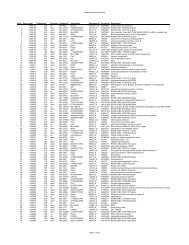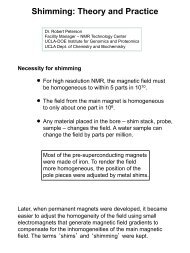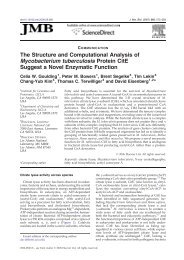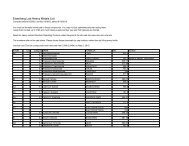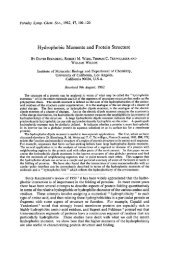In silico simulation of biological network dynamics - UCLA-DOE
In silico simulation of biological network dynamics - UCLA-DOE
In silico simulation of biological network dynamics - UCLA-DOE
Create successful ePaper yourself
Turn your PDF publications into a flip-book with our unique Google optimized e-Paper software.
LETTERS<br />
© 2004 Nature Publishing Group http://www.nature.com/naturebiotechnology<br />
<strong>In</strong> <strong>silico</strong> <strong>simulation</strong> <strong>of</strong> <strong>biological</strong> <strong>network</strong> <strong>dynamics</strong><br />
Lukasz Salwinski & David Eisenberg<br />
Realistic <strong>simulation</strong> <strong>of</strong> <strong>biological</strong> <strong>network</strong>s requires stochastic<br />
<strong>simulation</strong> approaches because <strong>of</strong> the small numbers <strong>of</strong><br />
molecules per cell. The high computational cost <strong>of</strong> stochastic<br />
<strong>simulation</strong> on conventional microprocessor-based computers<br />
arises from the intrinsic disparity between the sequential steps<br />
executed by a microprocessor program and the highly parallel<br />
nature <strong>of</strong> information flow within biochemical <strong>network</strong>s.<br />
This disparity is reduced with the Field Programmable Gate<br />
Array (FPGA)-based approach presented here. The parallel<br />
architecture <strong>of</strong> FPGAs, which can simulate the basic reaction<br />
steps <strong>of</strong> <strong>biological</strong> <strong>network</strong>s, attains <strong>simulation</strong> rates at least<br />
an order <strong>of</strong> magnitude greater than currently available<br />
microprocessors.<br />
Biological systems consist <strong>of</strong> thousands <strong>of</strong> simple elements linked<br />
together to form complex <strong>network</strong>s capable <strong>of</strong> adapting to a diversity <strong>of</strong><br />
stimuli 1 .The elements <strong>of</strong> those <strong>network</strong>s are molecules and molecular<br />
complexes within a cell. They perform simple tasks, such as amplification<br />
or integration <strong>of</strong> a signal 2,3 , and the complexity <strong>of</strong> the cellular<br />
response emerges from the structure and <strong>dynamics</strong> <strong>of</strong> the entire <strong>network</strong><br />
2–4 .To understand and predict the behavior <strong>of</strong> such <strong>network</strong>s<br />
under a realistic variety <strong>of</strong> external stimuli, efficient algorithms for <strong>simulation</strong><br />
are required because the kinetics <strong>of</strong> all but trivial biochemical<br />
<strong>network</strong>s cannot be described analytically. Moreover, because <strong>of</strong> the low<br />
abundance <strong>of</strong> some molecules within cells, Monte Carlo <strong>simulation</strong><br />
methods must be used to capture the stochastic behavior <strong>of</strong> the system.<br />
Exact Monte Carlo methods, pioneered nearly three decades ago by<br />
Gillespie 5 and subsequently improved 6–9 ,have been applied successfully<br />
to <strong>simulation</strong>s <strong>of</strong> small <strong>biological</strong> <strong>network</strong>s 10,11 .But <strong>simulation</strong> <strong>of</strong> larger<br />
<strong>network</strong>s approaching the size <strong>of</strong> those describing the behavior <strong>of</strong> entire<br />
cells has not yet been possible because <strong>of</strong> both limited experimental data<br />
and the high computational demands <strong>of</strong> the conventional stochastic<br />
algorithms 12 ,which scale at best as O(n log n) with the <strong>network</strong> size n.<br />
With the rise <strong>of</strong> various ‘omics’ approaches, the limitation <strong>of</strong> experimental<br />
data is being lifted, but the computational demands remain staggering<br />
for simulating <strong>network</strong>s <strong>of</strong> thousands <strong>of</strong> reactions involving<br />
thousands <strong>of</strong> reactants. The problem stems from the intrinsic disparity<br />
between the sequential nature <strong>of</strong> microprocessor architecture and the<br />
highly parallel nature <strong>of</strong> <strong>biological</strong> systems, with the result that <strong>simulation</strong><br />
times become prohibitively long.<br />
Here we demonstrate that a stochastic <strong>simulation</strong> algorithm can be<br />
efficiently implemented by using reprogrammable FPGA devices to build<br />
a microelectronic circuit that simulates the kinetics <strong>of</strong> biochemical <strong>network</strong>s.<br />
Such devices, built as an array <strong>of</strong> simple configurable logic blocks<br />
embedded in a programmable interconnection matrix, are ideally suited<br />
to implement highly parallel architectures comparable in complexity to<br />
biochemical <strong>network</strong>s. Circuits based on FPGAs scale efficiently so that<br />
<strong>simulation</strong>s <strong>of</strong> realistic <strong>biological</strong> systems should be possible.<br />
The basic building blocks <strong>of</strong> the design are shown in Figure 1a.The<br />
circuit simulates the elementary bimolecular reaction<br />
A + B → S<br />
The circuit is composed <strong>of</strong> N A , N B and N S counters that store the number<br />
<strong>of</strong> molecules <strong>of</strong> each reacting species as well as <strong>of</strong> a set <strong>of</strong> linear feedback<br />
shift register–based, pseudo-random number generators (RND A , RND B ,<br />
RND k ) and comparators. Every clock cycle, the generators are used to<br />
draw a sample from a random variable distribution that reflects the<br />
probability <strong>of</strong> the reaction progressing by one molecular step in a specified,<br />
discrete time interval. Networks <strong>of</strong> coupled reactions can be simulated<br />
by combining those building blocks into larger circuits with up to<br />
∼500 reactions fitting into a single, commercially available, integrated<br />
circuit. Larger systems can be simulated by partitioning the design<br />
between several FPGAs incorporated into a single device.<br />
When two or more reactions involving a particular reactive species are<br />
to progress concurrently within the same time step, additional control<br />
circuitry is used to resolve conflicts that arise.As currently implemented,<br />
all requested reactions may progress only when the net change <strong>of</strong> the<br />
number <strong>of</strong> molecules <strong>of</strong> interest is not greater than one; otherwise the<br />
progression <strong>of</strong> all the reactions changing the abundance <strong>of</strong> this molecule<br />
is cancelled.<br />
The size <strong>of</strong> the discrete time step is a key parameter that determines<br />
the speed <strong>of</strong> the <strong>simulation</strong>. It is limited by both the maximum expected<br />
probability <strong>of</strong> the cancellations mentioned above and by the rate <strong>of</strong> the<br />
fastest reaction within the simulated system. The expected probability <strong>of</strong><br />
cancellations, P cancel , is equal to a product:<br />
P cancel = P R1 × P R2<br />
where P R1 and P R2 are the probabilities that two competing reactions R1<br />
and R2 advance within the same discrete time interval. These probabilities<br />
can be controlled by adjusting the size <strong>of</strong> the time step.<br />
The rate <strong>of</strong> the most rapid reaction within the simulated system<br />
requires the time step to be adjusted so that the probability <strong>of</strong> more than<br />
a single pair <strong>of</strong> molecules undergoing this reaction within a given time<br />
interval is small when compared to the probability P R that exactly one<br />
<strong>UCLA</strong>-<strong>DOE</strong> <strong>In</strong>stitute for Genomics and Proteomics, Howard Hughes Medical <strong>In</strong>stitute, Molecular Biology <strong>In</strong>stitute, Box 951570, Los Angeles, California 90095-<br />
1570, USA. Correspondence should be addressed to D.E. (david@mbi.ucla.edu).<br />
Published online 4 July 2004; doi:10.1038/nbt991<br />
NATURE BIOTECHNOLOGY VOLUME 22 NUMBER 8 AUGUST 2004 1017
LETTERS<br />
© 2004 Nature Publishing Group http://www.nature.com/naturebiotechnology<br />
Figure 1 FPGA <strong>simulation</strong> <strong>of</strong> chemical reactions. (a) FPGA <strong>simulation</strong> <strong>of</strong> an<br />
elementary bimolecular reaction. The number <strong>of</strong> molecules <strong>of</strong> each reactive<br />
species is stored as a number within 16-bit bidirectional counters (N a , N b , N c )<br />
whereas constants, such as those defining the stochastic reaction rates are<br />
stored within 16-bit registers (N k ). After loading these with the initial values,<br />
the state <strong>of</strong> all the counters is updated, in two phases, every cycle <strong>of</strong> the system<br />
clock.<br />
Every rising edge <strong>of</strong> the clock triggers generation <strong>of</strong> a set <strong>of</strong> 16-bit random<br />
numbers by linear feedback shift register–based pseudo-random number<br />
generators 14 . The generated values are then compared with the current state<br />
<strong>of</strong> the relevant counters and registers. Because the random numbers generated<br />
by distinct generators are statistically independent, the probability that each <strong>of</strong><br />
them is smaller than the corresponding counter (register) value is:<br />
P t = P(RND A < N A , RND B < N B , RND k < N k ) = a × N A × N B<br />
where:<br />
N<br />
a = ————– k<br />
(2 16 –1) 3<br />
With a proper choice <strong>of</strong> N k , P t has the same distribution as the probability <strong>of</strong> the<br />
Sqrt(N)<br />
reaction:<br />
1,000 B<br />
Simulated trace<br />
A + B → C<br />
S<br />
progressing by one step within a predefined short time interval.<br />
500<br />
A random variable T with P t distribution is readily calculated by performing<br />
a logical AND operation on the comparators’ outputs. It can be used to update<br />
0<br />
the contents <strong>of</strong> the counters when triggered by the falling edge <strong>of</strong> the system<br />
0.0 1.0 2.0 3.0 4.0<br />
clock. <strong>In</strong> the case <strong>of</strong> the reaction modeled here, N A and N B counters would be<br />
Time (ms)<br />
incremented and N C decremented by one every time T = true, to reflect the<br />
occurrence <strong>of</strong> a single reactive event. (b) Stochastic <strong>simulation</strong> <strong>of</strong> a simple chemical equilibrium. The figure shows traces generated by a circuit designed to<br />
simulate a simple equilibrium described by an equation A + B = S. The simulated traces agree well with the analytical solution <strong>of</strong> the deterministic<br />
differential equations (dashed line) whereas the magnitude <strong>of</strong> the observed fluctuations scales with the square root <strong>of</strong> the system size, as expected (inset).<br />
pair reacts. The upper limit on the probability that the reaction<br />
progresses by more than one step within a given time interval can be<br />
estimated as:<br />
P<br />
P R<br />
multi ≈ ———— – P R ≈ P<br />
2<br />
(1 – P R<br />
R ) 2<br />
and again can be controlled by the appropriate choice <strong>of</strong> the time step<br />
size. <strong>In</strong> practice, setting the time interval so that the max(P R ) < 0.01 limits<br />
both P cancel and P multi to B<br />
A>B<br />
A>B<br />
A<br />
A + B<br />
S<br />
5<br />
Analytical solution<br />
0<br />
0 100 200<br />
Whereas time evolution <strong>of</strong> the above reaction can be analyzed analytically,<br />
the behavior <strong>of</strong> systems even slightly more complex, such as enzymatic<br />
reactions described by Michaelis-Menten equations, have to be<br />
simulated numerically even when the size <strong>of</strong> the system justifies deterministic<br />
description <strong>of</strong> the system. Figure 2 shows typical time courses<br />
generated by a FPGA circuit simulating simple Michaelis-Menten kinetics<br />
for a system <strong>of</strong> 200 substrate molecules and another <strong>of</strong> 20,000 substrate<br />
molecules. Notice that the simulated traces generated for the<br />
20,000 molecule system closely follow the deterministic solution <strong>of</strong> the<br />
corresponding set <strong>of</strong> coupled kinetic equations whereas the 200 molecule<br />
system reveals pronounced stochastic fluctuations around the<br />
deterministic values (dashed curves).<br />
Finally, to test the scalability <strong>of</strong> the FPGA approach we built a circuit<br />
that simulates prokaryotic gene expression according to the model <strong>of</strong><br />
Kierzek 13 .It is composed <strong>of</strong> 11 coupled reactions involving 12 distinct<br />
reactive species. Notice that despite a significant increase <strong>of</strong> the system<br />
complexity, its entire state has been updated every clock cycle, as in the<br />
preceding examples. The traces generated during FPGA-implemented<br />
<strong>simulation</strong> (Fig. 3) show good qualitative agreement with the results <strong>of</strong> a<br />
Gillespie-based <strong>simulation</strong>. Most notably, at low induction strength,<br />
pronounced stochastic fluctuations <strong>of</strong> the protein synthesis rate are easily<br />
observed.<br />
The above examples constitute a pro<strong>of</strong>-<strong>of</strong>-principle demonstration<br />
that reprogrammable FPGA technology can be applied to efficiently<br />
simulate stochastic behavior <strong>of</strong> <strong>biological</strong> systems. Such <strong>simulation</strong>s will<br />
ultimately be needed to understand and predict the dynamic behavior <strong>of</strong><br />
systems as complex as entire cells. Additionally, because <strong>of</strong> the broad<br />
spectrum <strong>of</strong> problems such as the kinetics <strong>of</strong> biochemical reactions that<br />
can be described using the same mathematical formalism—systems <strong>of</strong><br />
ordinary differential equations—the approach presented here can find<br />
application in other areas <strong>of</strong> research.<br />
INC<br />
N S<br />
Std(N A)<br />
AND<br />
20<br />
15<br />
10<br />
1018 VOLUME 22 NUMBER 8 AUGUST 2004 NATURE BIOTECHNOLOGY
LETTERS<br />
© 2004 Nature Publishing Group http://www.nature.com/naturebiotechnology<br />
Number <strong>of</strong> molecules<br />
Number <strong>of</strong> molecules<br />
20,000<br />
15,000<br />
10,000<br />
5,000<br />
0<br />
200<br />
150<br />
100<br />
50<br />
0<br />
0.0<br />
S<br />
S<br />
Simulated<br />
trace<br />
S + E ES P + E<br />
1.0 2.0 3.0 4.0<br />
Time (s × 10 –4 )<br />
METHODS<br />
All designs were implemented on D2/DIO2 boards (Digilent) that use SpartanII-<br />
200 FPGA (Xilinx). A USB interface based on USB MOD2C module (Elexol Pty)<br />
was designed to speed up communication between the FPGA and a Linux workstation<br />
used to collect and process data generated during <strong>simulation</strong> runs.<br />
The designs were described in VHDL hardware description language and<br />
processed within the ISE 6.1i (Xilinx) development environment to generate<br />
binary files ready to be downloaded into FPGA. Both the VHDL description <strong>of</strong><br />
the designs, as well as auxiliary programs used to initialize and control the <strong>simulation</strong>s,<br />
are available upon request.<br />
ACKNOWLEDGMENTS<br />
We thank Robert Grothe for helpful discussion, Stefan Czarnecki for engineering<br />
advice and an anonymous reviewer for valuable comments. This work was<br />
supported by the Howard Hughes Medical <strong>In</strong>stitute, Department <strong>of</strong> Energy<br />
and National <strong>In</strong>stitutes <strong>of</strong> Health.<br />
COMPETING INTERESTS STATEMENT<br />
The authors declare that they have no competing financial interests.<br />
ES<br />
ES<br />
Received 16 March; accepted 7 May 2004<br />
Published online at http://www.nature.com/naturebiotechnology/<br />
1. Hartwell, L.H., Hopfield, J.J., Leibler, S. & Murray, A.W. From molecular to modular<br />
cell biology. Nature 402, C47–C52 (1999).<br />
P<br />
20,000 substrate<br />
molecules<br />
Numerical<br />
solution<br />
P<br />
200 substrate<br />
molecules<br />
Figure 2 Stochastic <strong>simulation</strong> <strong>of</strong> the Michaelis-Menten kinetics. The figure<br />
shows traces generated by a circuit designed to simulate the well-known<br />
Michaelis-Menten kinetics <strong>of</strong> enzymatic reaction (S, substrate; P, product; E,<br />
free enzyme; ES, enzyme-substrate complex). For systems <strong>of</strong> both large and<br />
small size, the simulated traces (solid lines) agree well with the numerical<br />
solution (dashed lines) <strong>of</strong> the deterministic differential equations describing<br />
Michealis-Menten kinetics, whereas the magnitude <strong>of</strong> the observed fluctuations<br />
scales with the square root <strong>of</strong> the system size, as expected (not shown).<br />
Number <strong>of</strong> lacZ molecules<br />
20,000<br />
15,000<br />
10,000<br />
5,000<br />
0<br />
900<br />
600<br />
300<br />
Strong promoter<br />
Weak promoter<br />
Run 1<br />
Run 1<br />
Run 2<br />
0<br />
0 5 10 15 20<br />
6<br />
5<br />
Time (min)<br />
2<br />
3<br />
7<br />
8<br />
9<br />
Figure 3 Stochastic <strong>simulation</strong> <strong>of</strong> lacZ expression. A simplified model<br />
<strong>of</strong> lacZ expression (after refs. 13,15) was implemented within our FPGA<br />
device. Dynamics <strong>of</strong> the model were simulated at two levels <strong>of</strong> the promoter<br />
strength. The figure shows how the amount <strong>of</strong> the synthesized protein<br />
changed during independent runs (two traces for the strong and ten for the<br />
weak promoter). Notice the drastic increase <strong>of</strong> the noise level for the weak<br />
promoter case, qualitatively in agreement with the results <strong>of</strong> the <strong>simulation</strong>s<br />
with the Gillespie algorithm 13 .<br />
2. Bray, D. Protein molecules as computational elements in living cells. Nature 376,<br />
307–312 (1995).<br />
3. Tyson, J.J., Chen, K.C. & Novak, B. Sniffers, buzzers, toggles and blinkers: <strong>dynamics</strong> <strong>of</strong><br />
regulatory and signaling pathways in the cell. Curr. Opin. Cell Biol. 15, 221–231 (2003).<br />
4. Levchenko, A. Dynamical and integrative cell signaling: Challenges for the new biology.<br />
Biotechnol. Bioeng. 84, 773–782 (2003).<br />
5. Gillespie, D.T. Exact stochastic <strong>simulation</strong> <strong>of</strong> coupled chemical-reactions. J. Phys. Chem.<br />
Us. 81, 2340–2361 (1977).<br />
6. Gibson, M.A. & Bruck, J. Efficient exact stochastic <strong>simulation</strong> <strong>of</strong> chemical systems with<br />
many species and many channels. J. Phys. Chem. A 104, 1876–1889 (2000).<br />
7. Haseltine, E.L. & Rawlings, J.B. Approximate <strong>simulation</strong> <strong>of</strong> coupled fast and slow reactions<br />
for stochastic chemical kinetics. J. Chem. Phys. 117, 6959–6969 (2002).<br />
8. Gillespie, D.T. & Petzold, L.R. Improved leap-size selection for accelerated stochastic<br />
<strong>simulation</strong>. J. Chem. Phys. 119, 8229–8234 (2003).<br />
9. Rao, C.V. & Arkin, A.P. Stochastic chemical kinetics and the quasi-steady-state assumption:<br />
application to the Gillespie algorithm. J. Chem. Phys. 118, 4999–5010 (2003).<br />
10. Arkin, A., Ross, J. & McAdams, H.H. Stochastic kinetic analysis <strong>of</strong> developmental pathway<br />
bifurcation in phage lambda-infected Escherichia coli cells. Genetics 149,<br />
1633–1648 (1998).<br />
11. Kastner, J., Solomon, J. & Fraser, S. Modeling a Hox gene <strong>network</strong> in <strong>silico</strong> using a stochastic<br />
<strong>simulation</strong> algorithm. Dev. Biol. 246, 122–131 (2002).<br />
12. Endy, D. & Brent, R. Modelling cellular behaviour. Nature 409, 391–395 (2001).<br />
13. Kierzek, A.M. STOCKS: STOChastic kinetic Simulations <strong>of</strong> biochemical systems with<br />
Gillespie algorithm. Bioinformatics 18, 470–481 (2002).<br />
14. Pearson, R.B. An algorithm for pseudo random number generation suitable for large-scale<br />
integration. J. Comput. Phys. 49, 478–489 (1983).<br />
15. Kierzek, A.M., Zaim, J. & Zielenkiewicz, P. The effect <strong>of</strong> transcription and translation initiation<br />
frequencies on the stochastic fluctuations in prokaryotic gene expression. J. Biol.<br />
Chem. 276, 8165–8172 (2001).<br />
10<br />
4<br />
NATURE BIOTECHNOLOGY VOLUME 22 NUMBER 8 AUGUST 2004 1019



